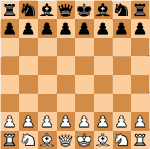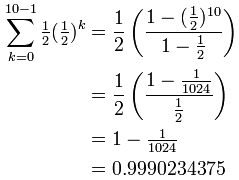How To Find R In A Geometric Sequence
Geometric Sequences and Sums
Sequence
A Sequence is a fix of things (usually numbers) that are in order.

Geometric Sequences
In a Geometric Sequence each term is found by multiplying the previous term by a abiding.
Example:
i, 2, 4, 8, xvi, 32, 64, 128, 256 , ...
This sequence has a gene of 2 between each number.
Each term (except the offset term) is found by multiplying the previous term by 2.

In General we write a Geometric Sequence like this:
{a, ar, ar2, ar3, ... }
where:
- a is the first term, and
- r is the factor between the terms (called the "common ratio")
Instance: {1,two,4,8,...}
The sequence starts at ane and doubles each time, and so
- a=i (the outset term)
- r=ii (the "mutual ratio" between terms is a doubling)
And we get:
{a, ar, arii, ar3, ... }
= {1, one×2, 1×2two, one×twoiii, ... }
= {1, 2, iv, 8, ... }
But exist careful, r should not be 0:
- When r=0, we go the sequence {a,0,0,...} which is not geometric
The Rule
Nosotros can likewise calculate any term using the Rule:
10n = ar(n-1)
(We use "north-1" because ar0 is for the 1st term)
Example:
10, 30, 90, 270, 810, 2430, ...
This sequence has a factor of three betwixt each number.
The values of a and r are:
- a = 10 (the first term)
- r = 3 (the "common ratio")
The Dominion for whatever term is:
xnorth = 10 × 3(n-i)
So, the 4th term is:
xiv = 10×iii(4-i) = 10×three3 = x×27 = 270
And the 10th term is:
x10 = 10×3(10-ane) = 10×iii9 = 10×19683 = 196830
A Geometric Sequence can likewise have smaller and smaller values:
Example:
This sequence has a gene of 0.5 (a one-half) betwixt each number.
Its Dominion is 10n = four × (0.5)due north-ane
Why "Geometric" Sequence?
Because it is similar increasing the dimensions in geometry:
 | a line is i-dimensional and has a length of r |
| in two dimensions a foursquare has an expanse of rii | |
| in 3 dimensions a cube has volume r3 | |
| etc (yeah we tin can have 4 and more dimensions in mathematics). |
Geometric Sequences are sometimes called Geometric Progressions (G.P.'s)
Summing a Geometric Series
To sum these:
a + ar + artwo + ... + ar(due north-ane)
(Each term is ark , where k starts at 0 and goes upwardly to due north-i)
We tin use this handy formula:

a is the first term
r is the "common ratio" betwixt terms
due north is the number of terms
What is that funny Σ symbol? It is chosen Sigma Notation
| | (called Sigma) ways "sum up" |
And below and in a higher place it are shown the starting and ending values:

It says "Sum upward n where n goes from one to 4. Answer=10
The formula is easy to employ ... just "plug in" the values of a, r and northward
Example: Sum the outset iv terms of
ten, xxx, ninety, 270, 810, 2430, ...
This sequence has a gene of 3 betwixt each number.
The values of a, r and n are:
- a = 10 (the commencement term)
- r = 3 (the "mutual ratio")
- n = 4 (we want to sum the first 4 terms)
And then:

Becomes:

You tin can bank check it yourself:
x + 30 + 90 + 270 = 400
And, yes, it is easier to just add together them in this example, every bit in that location are but 4 terms. But imagine adding 50 terms ... then the formula is much easier.
Using the Formula
Let's see the formula in action:
Instance: Grains of Rice on a Chess Board

On the page Binary Digits we give an example of grains of rice on a chess lath. The question is asked:
When we place rice on a chess board:
- 1 grain on the showtime square,
- two grains on the second square,
- iv grains on the tertiary and and then on,
- ...
... doubling the grains of rice on each square ...
... how many grains of rice in full?
And then we accept:
- a = 1 (the starting time term)
- r = 2 (doubles each fourth dimension)
- n = 64 (64 squares on a chess board)
Then:

Becomes:

= 1−264 −ane = 264 − 1
= 18,446,744,073,709,551,615
Which was exactly the result we got on the Binary Digits page (give thanks goodness!)
And some other example, this time with r less than 1:
Example: Add upwards the commencement x terms of the Geometric Sequence that halves each time:
{ 1/ii, i/4, 1/8, i/16, ... }
The values of a, r and northward are:
- a = ½ (the first term)
- r = ½ (halves each time)
- n = 10 (10 terms to add)
And then:

Becomes:

Very close to 1.
(Question: if we go along to increase n, what happens?)
Why Does the Formula Work?
Permit'due south meet why the formula works, considering we go to apply an interesting "trick" which is worth knowing.
Commencement, call the whole sum "S": S = a + ar + arii + ... + ar(north−2) + ar(north−1)
Next, multiply S past r: South·r = ar + artwo + ar3 + ... + ar(n−1) + arn
Notice that S and S·r are similar?
At present decrease them!

Wow! All the terms in the middle neatly cancel out.
(Which is a not bad trick)
By subtracting S·r from Due south we get a simple consequence:
S − Due south·r = a − arn
Allow'south rearrange it to find S:
Cistron out S and a: Due south(1−r) = a(1−rn)
Dissever by (one−r): S = a(1−rn) (1−r)
Which is our formula (ta-da!):

Space Geometric Serial
So what happens when northward goes to infinity?
We can use this formula:

Simply be careful:
r must be between (only not including) −1 and 1
and r should not be 0 because the sequence {a,0,0,...} is non geometric
And then our infnite geometric series has a finite sum when the ratio is less than ane (and greater than −ane)
Let's bring dorsum our previous instance, and come across what happens:
Case: Add together upward ALL the terms of the Geometric Sequence that halves each time:
{ one 2 , i 4 , one 8 , 1 16 , ... }
We have:
- a = ½ (the first term)
- r = ½ (halves each fourth dimension)
And and then:

= ½×1 ½ = 1
Yes, adding ane 2 + 1 4 + 1 8 + ... etc equals exactly one.
| Don't believe me? Only look at this foursquare: By adding up 1 2 + i four + 1 8 + ... we end upwardly with the whole thing! |  |
Recurring Decimal
On another folio we asked "Does 0.999... equal 1?", well, let usa run into if we can summate it:
Example: Calculate 0.999...
We tin can write a recurring decimal as a sum like this:

And now we can use the formula:

Yes! 0.999... does equal ane.
And so at that place nosotros have it ... Geometric Sequences (and their sums) can do all sorts of amazing and powerful things.
Source: https://www.mathsisfun.com/algebra/sequences-sums-geometric.html
Posted by: bukowskiolow1967.blogspot.com


0 Response to "How To Find R In A Geometric Sequence"
Post a Comment